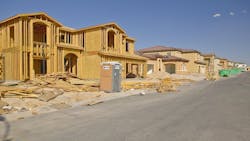Affordability Issues Persist in an Unbalanced Housing Market
The fact that the middle class continues to grapple with unattainable home prices is evidence that the U.S. housing affordability gap is ongoing. According to the 2025 Housing Affordability & Supply report from the National Association of Realtors and Realtor.com, U.S. households earning $75,000 annually can now only afford 21.2% of home listings. This is, however, better than the same time last year when that group could afford just 20.8% of homes for sale. The likely reason for the improvement is that housing inventory has grown by 20% over the last year.
Despite this, households earning $75,000 per year still have less than half of the access to affordable homes that they had before the pandemic when nearly 49% of listings were considered affordable.
For the market to be considered balanced, households earning $75,000 per year would need 48.1% of listings to be accessible. To reach that threshold, the market would need nearly 416,000 more listings priced at or below $255,000.
The Housing Affordability & Supply report examines the current state of housing affordability in the U.S. by analyzing the availability of affordable homes in different U.S. housing markets across a variety of income levels.
Which markets are moving toward closing the affordability gap?
An unbalanced housing market occurs when housing supply doesn't match demand. When we're talking about the affordability gap, many U.S. housing markets still aren’t considered fully balanced, but some are making progress toward greater balance. As of March 2025, 30% of the 100 largest metro areas in the U.S. had seen availability of affordable homes improve over the past year.
Akron, Ohio; St. Louis; Youngstown, Ohio; and Pittsburgh are all seeing relatively healthy inventory levels. Additionally, Raleigh, N.C.; Des Moines, Iowa; Grand Rapids, Mich.; Columbia, S.C.; and Columbus, Ohio, are not fully balanced but have all made substaintial headway to becoming more affordable.
But in addition to the 30% of metros moving toward more balance, the report classifies 44% of metros as "Areas Stuck in the Middle" and 26% as "Areas Falling Further Behind."
Of U.S. states, Montana, Idaho, California, Massachusetts, and Hawaii have the largest shortfalls in affordable housing.
What the experts are saying about housing supply and affordability
"The housing market is at a turning point," says Nadia Evangelou, NAR senior economist and director of real estate research. "More homes are hitting the market, and it's encouraging to see the greatest housing-supply gains among middle-income home buyers."
"Shoppers see more homes for sale today than one year ago, and encouragingly, many of these homes have been added at moderate income price points," says Danielle Hale, chief economist at housing market platform Realtor.com. "But as this report shows, we still don't have an abundance of homes that are affordable to low- and moderate-income households, and the progress that we've seen is not happening everywhere. It's been concentrated in the Midwest and the South."
Inventory has rebounded slightly since 2020, but is it enough?
- Active Inventory Improves Across the U.S.: As of March 2025, seven states saw home inventory return to pre-pandemic levels, but nationwide, inventory is still down by 20%.
- Active Listings Rise, But Most Buyers Won’t Take the Bait: Some metros are seeing active inventory improve, but that doesn't mean buyers are returning to the marketplace.
